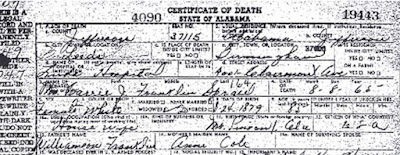Locating "Lost" Female Ancestors
by Mary Beth Newbill, Southern History Department, Central Library
Sometimes our female ancestors can be frustratingly difficult to document. Many times genealogists hit the infamous "brick wall" because they can't locate a woman's maiden name or even her first name if she is listed in records with her husband's name (ex. Mrs. John Smith). Since March is Women's History Month, I'd like to point out some resources that, along with a little diligence and creativity, can help identify those elusive female ancestors.
The traditional sources are always a good place to start. Even a very familiar record can yield new information if you start to look at it differently. We all know that death certificates are a great place to find a person's date and cause of death. But if you start truly mining the record, you can glean other pieces of information. In the example below, the death certificate of Carrie Spraul not only gives me her father's name and, thus, Carrie Spraul's maiden name, it also gives me her mother's maiden name. With this information, I can continue my research on both Carrie Spraul's maternal and paternal lines.
Census records are another great example of a familiar source that can give us clues to our female ancestors. Finding a multi-generational household in which the occupants have different surnames could mean you have found members of the wife's family.
Often it's not just a woman's last name that can't be found, it's her first name as well. Upon marriage many women cease to be referred to by their first names and are only addressed by their husband's name. The marriage license is the first place to look for the wife's full name. However, if you have access to city directories, they can also be a great place to locate the given name of someone's spouse. The example below shows a 1905 Birmingham city directory that lists the name of the wife in parenthesis after her husband's name:
Since the records we often use for genealogical research were made by and for men, locating a lost female ancestor takes time and persistence. However, by engaging in careful research you will be well on your way to making sure they do not stay lost.
For additional information on researching the women in your family, follow the links below:
8 Records that May Reveal Your Female Ancestor
When Saying "I Do" Meant Losing Your U.S. Citizenship
3 Ways to Unravel the Mysteries of Women in Your Family Tree
The Hidden Half of the Family: A Sourcebook for Women's Genealogy
A Genealogist's Guide to Discovering Your Female Ancestors
Sometimes our female ancestors can be frustratingly difficult to document. Many times genealogists hit the infamous "brick wall" because they can't locate a woman's maiden name or even her first name if she is listed in records with her husband's name (ex. Mrs. John Smith). Since March is Women's History Month, I'd like to point out some resources that, along with a little diligence and creativity, can help identify those elusive female ancestors.
The traditional sources are always a good place to start. Even a very familiar record can yield new information if you start to look at it differently. We all know that death certificates are a great place to find a person's date and cause of death. But if you start truly mining the record, you can glean other pieces of information. In the example below, the death certificate of Carrie Spraul not only gives me her father's name and, thus, Carrie Spraul's maiden name, it also gives me her mother's maiden name. With this information, I can continue my research on both Carrie Spraul's maternal and paternal lines.
Census records are another great example of a familiar source that can give us clues to our female ancestors. Finding a multi-generational household in which the occupants have different surnames could mean you have found members of the wife's family.
Often it's not just a woman's last name that can't be found, it's her first name as well. Upon marriage many women cease to be referred to by their first names and are only addressed by their husband's name. The marriage license is the first place to look for the wife's full name. However, if you have access to city directories, they can also be a great place to locate the given name of someone's spouse. The example below shows a 1905 Birmingham city directory that lists the name of the wife in parenthesis after her husband's name:
Since the records we often use for genealogical research were made by and for men, locating a lost female ancestor takes time and persistence. However, by engaging in careful research you will be well on your way to making sure they do not stay lost.
For additional information on researching the women in your family, follow the links below:
8 Records that May Reveal Your Female Ancestor
When Saying "I Do" Meant Losing Your U.S. Citizenship
3 Ways to Unravel the Mysteries of Women in Your Family Tree
The Hidden Half of the Family: A Sourcebook for Women's Genealogy
A Genealogist's Guide to Discovering Your Female Ancestors


Comments